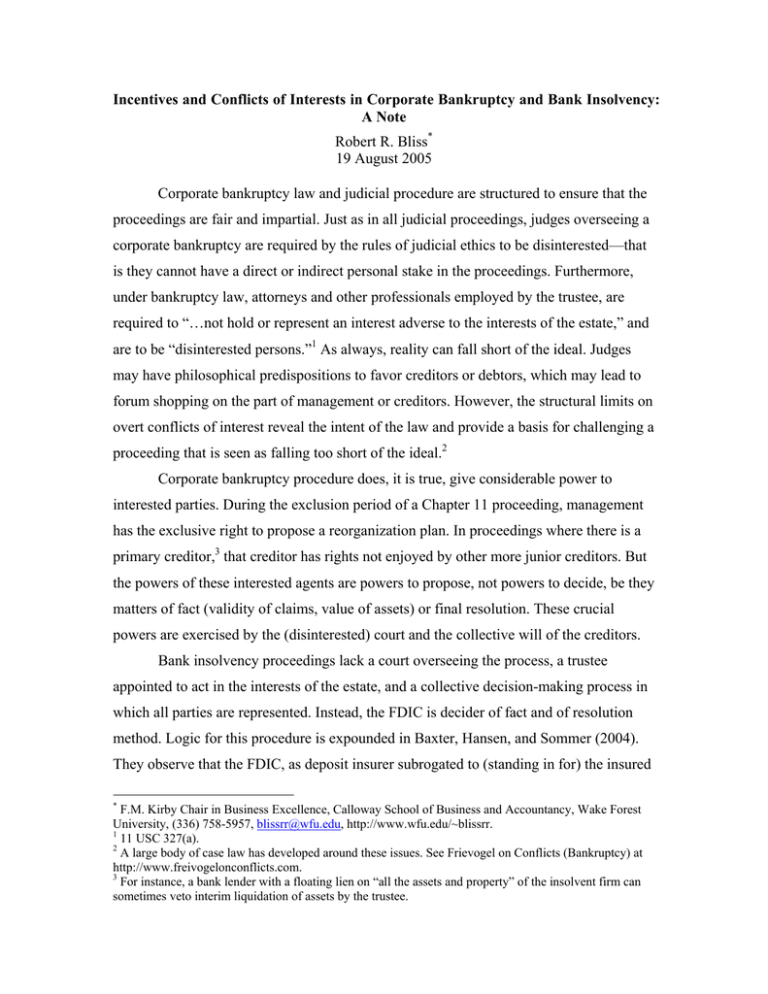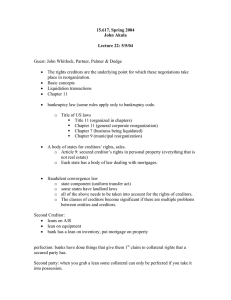Incentives and Conflicts of Interests in Corporate Bankruptcy and Bank Insolvency: A Note Robert R. Bliss
advertisement

Incentives and Conflicts of Interests in Corporate Bankruptcy and Bank Insolvency: A Note Robert R. Bliss* 19 August 2005 Corporate bankruptcy law and judicial procedure are structured to ensure that the proceedings are fair and impartial. Just as in all judicial proceedings, judges overseeing a corporate bankruptcy are required by the rules of judicial ethics to be disinterested—that is they cannot have a direct or indirect personal stake in the proceedings. Furthermore, under bankruptcy law, attorneys and other professionals employed by the trustee, are required to “…not hold or represent an interest adverse to the interests of the estate,” and are to be “disinterested persons.”1 As always, reality can fall short of the ideal. Judges may have philosophical predispositions to favor creditors or debtors, which may lead to forum shopping on the part of management or creditors. However, the structural limits on overt conflicts of interest reveal the intent of the law and provide a basis for challenging a proceeding that is seen as falling too short of the ideal.2 Corporate bankruptcy procedure does, it is true, give considerable power to interested parties. During the exclusion period of a Chapter 11 proceeding, management has the exclusive right to propose a reorganization plan. In proceedings where there is a primary creditor,3 that creditor has rights not enjoyed by other more junior creditors. But the powers of these interested agents are powers to propose, not powers to decide, be they matters of fact (validity of claims, value of assets) or final resolution. These crucial powers are exercised by the (disinterested) court and the collective will of the creditors. Bank insolvency proceedings lack a court overseeing the process, a trustee appointed to act in the interests of the estate, and a collective decision-making process in which all parties are represented. Instead, the FDIC is decider of fact and of resolution method. Logic for this procedure is expounded in Baxter, Hansen, and Sommer (2004). They observe that the FDIC, as deposit insurer subrogated to (standing in for) the insured * F.M. Kirby Chair in Business Excellence, Calloway School of Business and Accountancy, Wake Forest University, (336) 758-5957, blissrr@wfu.edu, http://www.wfu.edu/~blissrr. 1 11 USC 327(a). 2 A large body of case law has developed around these issues. See Frievogel on Conflicts (Bankruptcy) at http://www.freivogelonconflicts.com. 3 For instance, a bank lender with a floating lien on “all the assets and property” of the insolvent firm can sometimes veto interim liquidation of assets by the trustee. depositors, is a residual creditor of the insolvent bank.4 Citing arguments in Fama and Jensen (1983b), Baxter et al conclude that the FDIC’s incentives are aligned with maximizing the recovery value of assets.5 However, such a conclusion is not obvious. The incentive arguments in Fama and Jensen (1983b) presume that the residual creditors are alike (either in their control or lack of control over the decisions of the firm). This analysis breaks down if 1) there is more than one residual creditor, and 2) the processcontrolling residual creditor can take actions that produce private gains outside the insolvency resolution to offset shared losses within the insolvency resolution.6 Interests outside the estate that could divide the interests of multiple residual creditors need not be directly financial.7 A related paper, Fama and Jensen (1983a) highlights a different problem. Banks are corporations (by law) and following Fama and Jensen, the corporate form solves the agency problem (arising from separation of ownership and control) by separating management (initiating and implementing decisions) from control (ratifying and monitoring). The agents who control are the board of directors who are elected by the equity holders and are charged to act in their interests. Solvent banks are also corporations and share the board of directors/managers structure with non-bank corporations. While numerous recent financial scandals have shown that the separation of management and control is sometimes imperfect, the persistent success of the corporate form of business organization suggests that sufficient mitigation of agency problems is being realized. In corporate bankruptcy, the “management” function is vested in the trustee or the debtor in possession (managers, in Chapter 11 during the exclusionary period), while 4 When a firm is in receivership (liquidation) the residual creditor or claimant is the one who benefits by an additional dollar of recovery. The residual creditor may be thought of as a “marginal” creditor and rather than being contractual (c.f., the residual claim on cash flows rights of stockholders), depends on the liquidation value of assets and the distribution of claims of different priority. 5 We have already argued that depositor preference may be expected to tend to align the interests of the FDIC with those of domestic depositors. 6 For instance, a manager who holds shares in a firm, is a residual claimant as are other stockholders. However, unlike other shareholders he retains control rights. Managerial equity stakes are thought to mitigate but not eliminate agency problems. In Chapter 11, managers may privately gain more by prolonging a resolution than they lose through diminished value of their equity stakes. Other residual claimants, the non-managerial shareholders just lose. 7 For instance, past experience has shown that deposit insurers are at times subjected to political pressures to act in ways not necessarily in the best interests of the creditors of the bank (PCA is designed in part to mitigate such pressures). 2 monitoring and ratification are shared by the court and creditors. However, this system of checks and balances is removed when a bank is placed into receivership. Both management and control are assumed by a single agent, the FDIC; the original owners are dispossessed of their ownership rights, and while they retain a financial claim it is unlikely to be “residual” in practice;8 in most cases, the uninsured domestic depositors along with the FDIC itself become the residual claimants. Just as with corporations whose managers own shares, FDIC participation in residual cash flows may mitigate agency problems, but is unlikely to completely eliminate them. When the FDIC no longer shares in the residual cash flows (that is, when assets are sufficient to cover domestic deposits) there is no theoretical alignment of interests.9 The presumption—frequently implicit, though made explicit by Baxter et al—that the FDIC is the residual creditor is not necessarily true, though it has been true in the small, purely domestic bank insolvencies that have occurred since depositor preference was passed. Importantly, for large, complex, multinational banks this assumption is likely to be false. Large, complex, multinational banks have substantial proportions of foreign deposits and non-deposit creditors who are subordinated to the domestic depositors with whom the FDIC’s incentives are (partially) aligned. The interests of senior creditors who do not expect to suffer losses may well be “adverse to the estate” of the insolvent bank as a whole and junior (i.e. general) creditors in particular. One might expect, for instance, that the interests of senior, fully-protected creditors in a quick resolution might conflict with the interests of junior creditors in maximizing the recovery value of the insolvent bank. Furthermore, unlike bankruptcy law which seeks to ensure that the agents employed to handle the administrative details are disinterested, in a bank insolvency the agents who carry out the administrative processes attendant to the insolvency resolution (collection and validation claims, valuation and disposition of assets, payment of proceeds) are themselves employees of the FDIC, an interested party. 8 To be a residual claimant any marginal increase in the value of the insolvency estate must accrue to that party. If the increase is large enough to cover one party’s claim, the next junior creditor then becomes residual. In most bank insolvencies, share holders have no hope of recovery. 9 This is not to say that the FDIC has acted or would act inappropriately, only that the incentives they face are not necessarily compatible with the interests of other creditors. 3 Baxter et al point out that the possibility of FDIC opportunism is intended to be limited by least cost resolution and the requirement that no creditor may be worse off than it would be under a straightforward liquidation (12 USC 18??). This should in theory provide protection against adverse incentives attendant to granting “receiver superpowers”10 to an interested party. However, asset value maximizing incentives under least cost resolution are effective only if the FDIC (and other domestic depositors) are the residual creditors (expect to suffer losses), which is not necessarily always the case.11 One may also doubt the degree of practical protection that the “no worse off” provision provides. As Baxter et al note in another context, FDIA provides the theoretical means for directors to appeal the appointment of a receiver but “the decision to declare bank insolvencies is nearly unreviewable de facto. An aggrieved party may have its day in court, but is almost certain to lose” (p. 65) because courts are deferential to administrative agencies on findings of fact. Mounting a challenge under the “no worse off” rule would also be impeded by the practical difficulties of proving a counter-factual and the lack of public, detailed information as to assets, valuations, and recoveries (other than aggregate numbers) on which to base such an analysis and claim. The potential conflicts of interests faced by the FDIC administrator/creditor are apt to be mitigated in most bank insolvencies by their status as residual (and frequently majority) creditor. In these cases, the potential agency costs may be outweighed by the efficiency gains of an administrative process administered by an administrator with experience conducting bank insolvencies and well-positioned through its on-going relations with other banks to expeditiously find buyers for liabilities and assets. However, when the FDIC is no longer the residual creditor, the potential conflicts of interest are likely to be exacerbated and the limited experience of the FDIC (or any other agency for that matter) in handling large complex bank insolvencies would reduce the “experience brings efficiency” arguments counterbalancing the agency cost considerations. It may, therefore, be reasonable to ask whether, at least for large bank insolvencies, the granting of receiver superpowers to a major creditor might set up adverse incentives for the 10 The term used by Baxter, Hansen, and Sommer (2004) to characterize the “powers that go far beyond the powers of even a bankruptcy court.” (p. 72). 11 Least cost resolution is defined in terms of losses to the FDIC insurance fund. Once the domestic depositors’ claims are fully covered losses to the FDIC are zero, and least cost resolution is obtained. 4 collectively optimal resolution of all creditors’ claims, and whether the “disinterested agent” structures embedded in corporate insolvency might have value. Bibliography Baird, Douglas G. and Thomas H. Jackson, 1988, “Bargaining After the Fall and the Contours of the Absolute Priority Rule”, University of Chicago Law Review 55, Summer, 738–789. Baxter, Thomas C., Jr., Joyce Hansen, and Joseph H. Sommer, 2004, “Two Cheers for Territoriality: An Essay on International Bank Insolvency Law”, The American Bankruptcy Law Journal 78(1), Winter, 57–91. Fama, Eugene F. and Michael C. Jensen, 1983a, “Separation of Ownership and Control”, Journal of Law and Economics 26(2), June, 301–325. Fama, Eugene F. and Michael C. Jensen, 1983b, “Agency Problems and Residual Claims”, Journal of Law and Economics 26(2), June, 327–349. 5


